 Technology peripherals
Technology peripherals
 AI
AI
 Application of multimodal DNN models in drug interaction prediction tasks
Application of multimodal DNN models in drug interaction prediction tasks
Application of multimodal DNN models in drug interaction prediction tasks

1. Background introduction
First of all, let me share with you the relevant background of drug discovery.
1. Background introduction
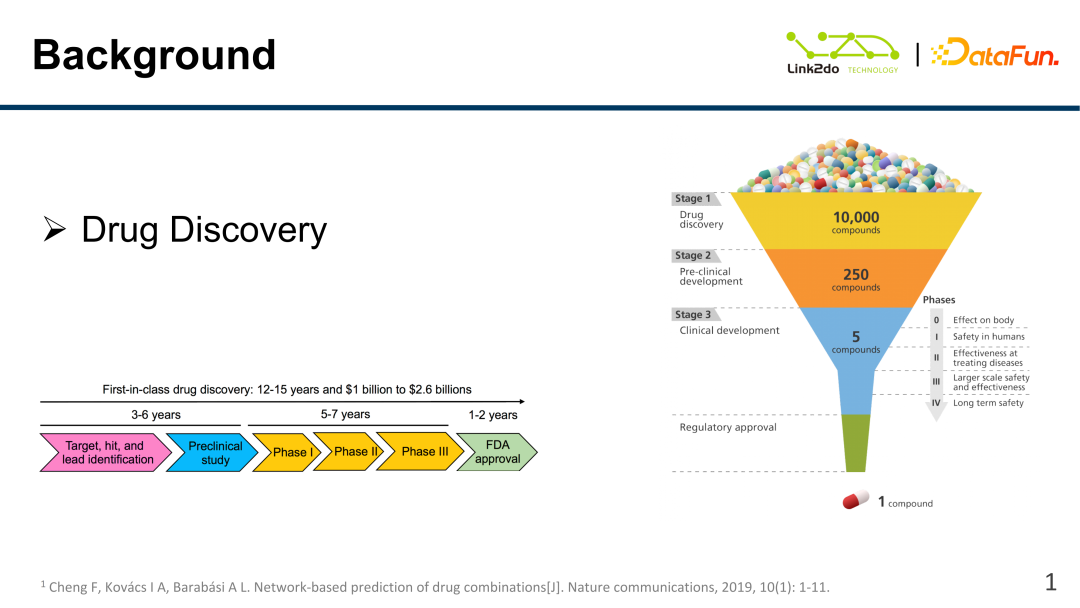
##Drugs The field of discovery has been very hot in recent years, especially the use of AI to assist pharmaceutical companies in their drug discovery work, including drug research and development. The drug research and development process is very long. Usually, the research and development process of the first drug for a certain type of clinical disease requires billions of funds and more than ten years. It is mainly divided into the following stages:
# (1) Research on disease targets and confirmation of disease core proteins.
# (2) Verify the effectiveness of the drug before clinical trials: including research on drug toxicity, effectiveness, taking methods, etc.
# (3) Clinical trials.
# (4) FDA approval and certification.
#So the traditional drug research and development process cycle is very long. In addition, from the initial recognition of more than 10,000 drugs, 5 drugs entered the clinical trial stage, and finally only 1 drug was approved for marketing. In this context, how to assist pharmaceutical companies to more quickly select effective drugs from candidate drugs, and how to quickly pre-investigate the effects, effects, and effectiveness of drugs in the clinical testing phase has become a hot research topic. field, in which AI, especially deep neural network technology, can greatly accelerate the drug development process.

2. Questions raised
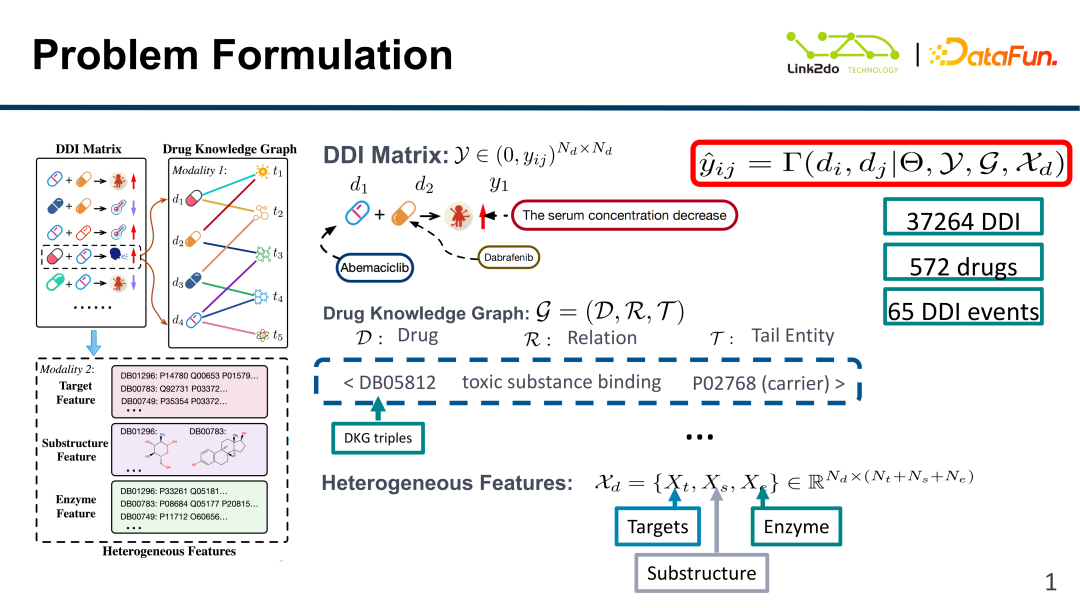
As shown in the figure above, drug interactions can be summarized as a DDI matrix, which describes the results of drug interactions, such as drugs d1 (abexiclib) and d2 (dabrafenib) Will cause y1 (decreased serum concentration). This study included 37,264 DDI data, involving 572 drugs (d) and 65 reaction results (y, such as decrease in serum concentration, etc.). And based on this data, a Drug Knowledge Graph (DKG) was constructed: the nodes are drugs and the edges are the relationships between drugs. The DKG triple is {D: drug, R: inter-drug relationship, T: tail entity}.
#In addition to the above data, the multimodal model also incorporates the heterogeneous features of the drug (HF, Heterogeneous Features): {Target: target, substructure: Composition/chemical structure, enzyme: enzyme}, the dimensions of each feature are different, for example, the target information is a protein. Finally, the DDI matrix, DKG and HF are fused on the same probability distribution for modeling.
2. Introduction to MDNN model
Next, we will introduce the framework of the heterogeneous multi-modal MDNN model.
1. MDNN overall framework
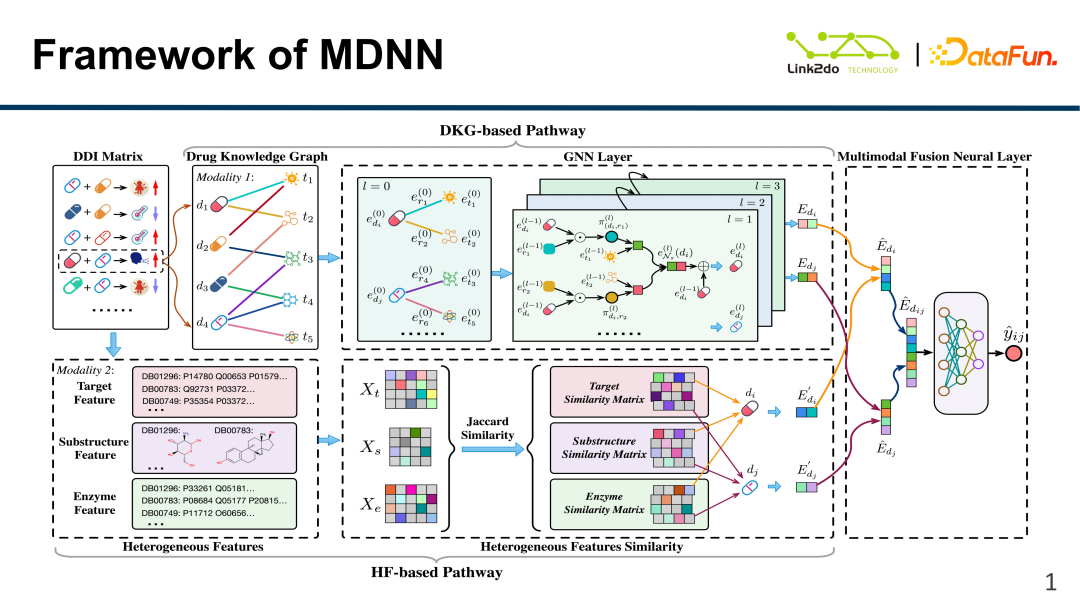
## This model is referred to as MDNN. The basic data is mainly divided into two parts: DDI matrix and heterogeneous data. The model framework mainly consists of the following three parts:
# #(1) Based on the DKG part: Mainly expresses information about the components of the drug itself (active ingredients, toxic ingredients), relationships between drugs, etc. by constructing a drug knowledge graph.
(2) Based on the HF part: Describe the drug itself by integrating heterogeneous characteristic data such as targets, enzymes, and molecular structures. Basic feature information.
(3) Multi-modal fusion neural network: Effectively fuse the two parts of feature data, DKG and HF, and perform Unified modeling.
2. DKG module constructionThe following will introduce the construction process based on DKG.
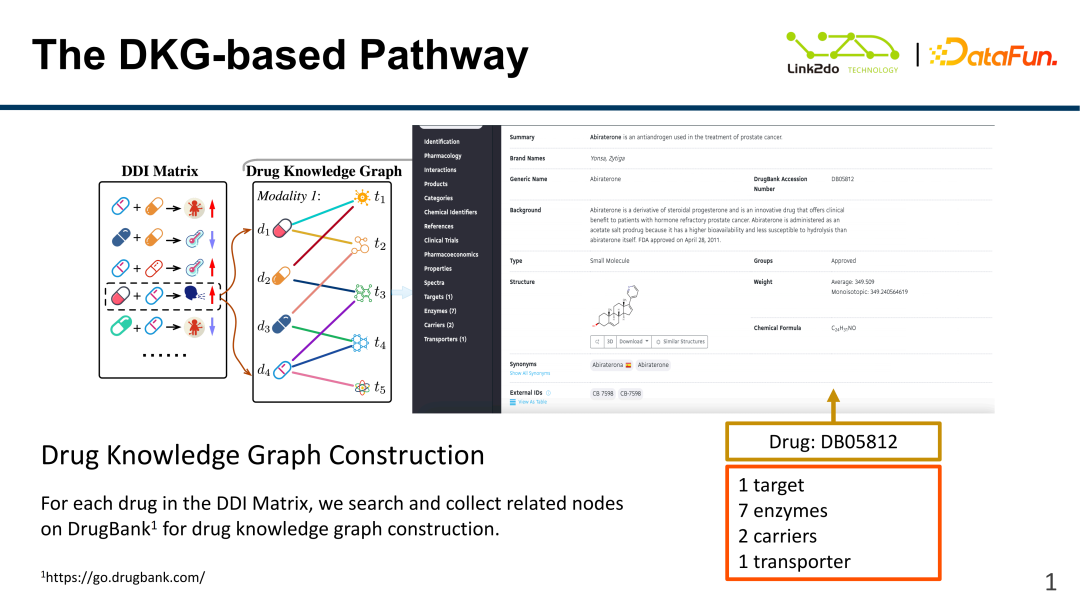
The above picture shows the main content of the drug knowledge graph. The left picture is the DDI matrix. The matrix contains nearly 600 drugs, and the composition and action information of these drugs are stored in the database (DrugBank, that is, "Drug Bank"). The picture on the right shows an example of drug information in the "Drug Bank", such as heterogeneous basic features such as enzymes, carriers, targets, etc. Among them, 4 features are relatively important. Taking the drug DB05812 as an example, in addition to target, In addition to enzymes and molecular structures, there are also carriers and transporters. However, these two types of data are relatively sparse and do not have as many dimensions as other features. The distinction in the current data set is not large. Therefore, these two data are not used for the time being. The main data used are targets, enzymes, and molecular structures.
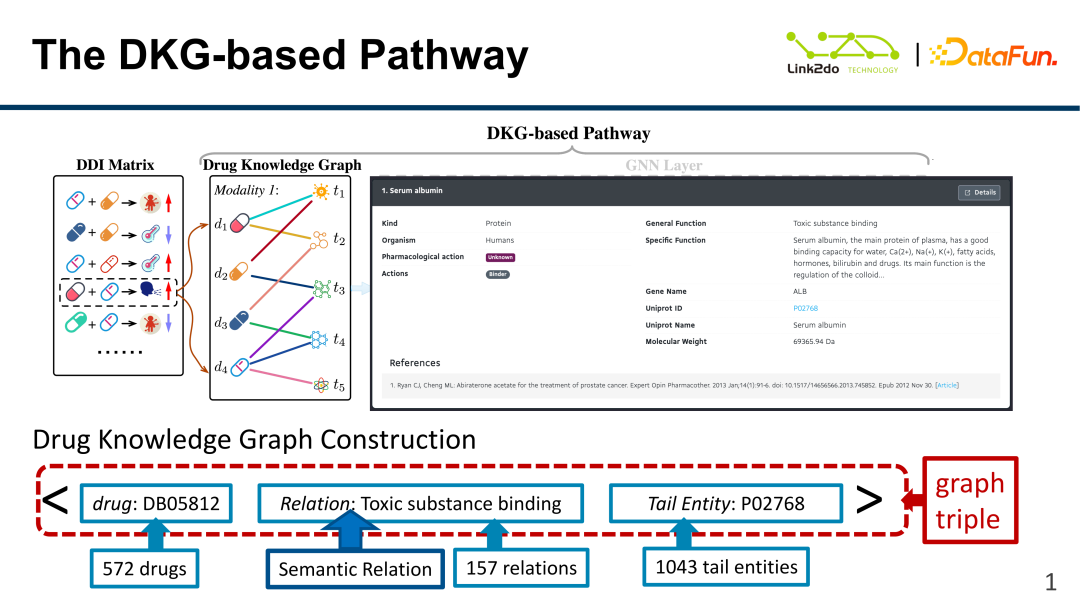
As shown in the figure above, the knowledge graph is mainly composed of nodes and edges, where the nodes are drugs and ingredients, and the edges are relationships. The relationship displayed by the triplet in the example is the toxic component relationship, that is, there is a toxic component relationship between the node drug "DB05812" and the node component "P02768". Based on the drug ingredient relationship triples obtained from the "Drug Bank", the DKG knowledge graph is formed, which contains 572 kinds of drugs. The edges (relationships) of the triples are called semantic relations. There are 157 relationship types in total. Ingredients There are 1043 types of tail entity nodes. Each DKG can extract corresponding information from the "Drug Bank" according to task requirements and construct it, so the DKG is equivalent to a subgraph in the "Drug Bank" knowledge graph.

Based on DKG, two types of information are summarized. The above figure shows the semantic relationship information model of construction. Based on the toxic components, first calculate the inner product of the drug (d) and the relationship (r) in the previous layer, and sum it up through the current layer weight (W1) to get the π function, that is, the edge and node information of the drug are summed together through the π function , and then perform a weighted summation of the π function and the previous layer component (t) to obtain e, that is, the edge information is obtained.
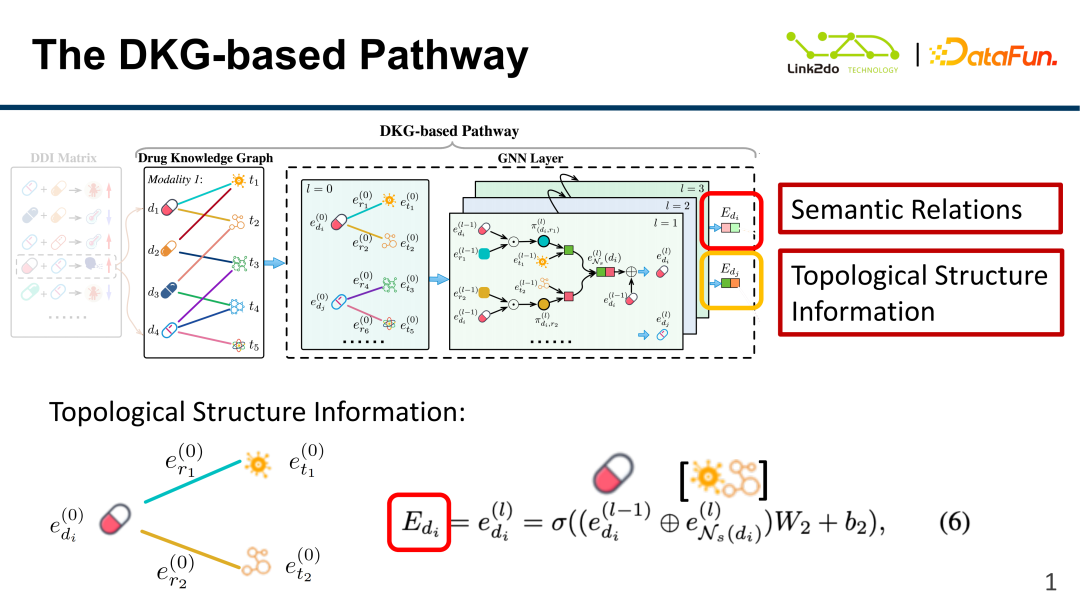
Similarly, the above figure shows the construction of the topological structure information model of the graph. In addition to toxic components, drugs may also contain multiple other component relationships. Multiple relationships (edges, i.e. e) of the same drug and their corresponding weights W2 can be connected to finally obtain the E corresponding to each drug. Through the above method, DKG edges and topological structure information are effectively fused and represented.
3. HF module construction
As shown below, in addition to the side information and DDI information mentioned above, There is also very rich multi-modal information in drugs: the same drug can act on multiple targets; various drugs also have different molecular structures, representing their corresponding molecular properties; drugs will react under the action of different enzymes. combined with different targets. These three types of information are vectorized, and then the similarity between drugs is measured through simple Jaccard similarity to obtain the corresponding similarity matrix.
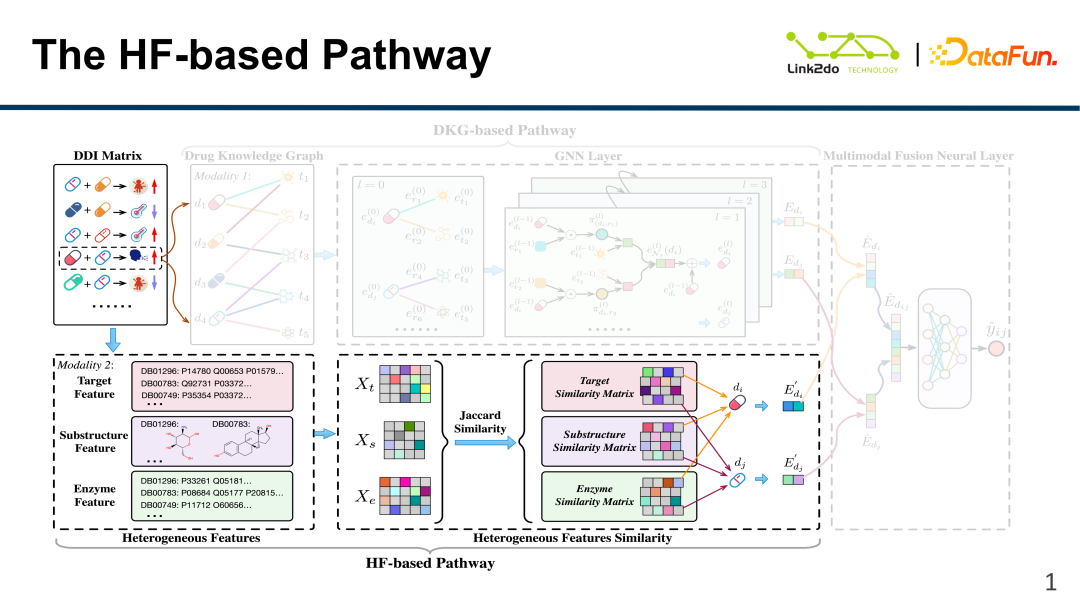
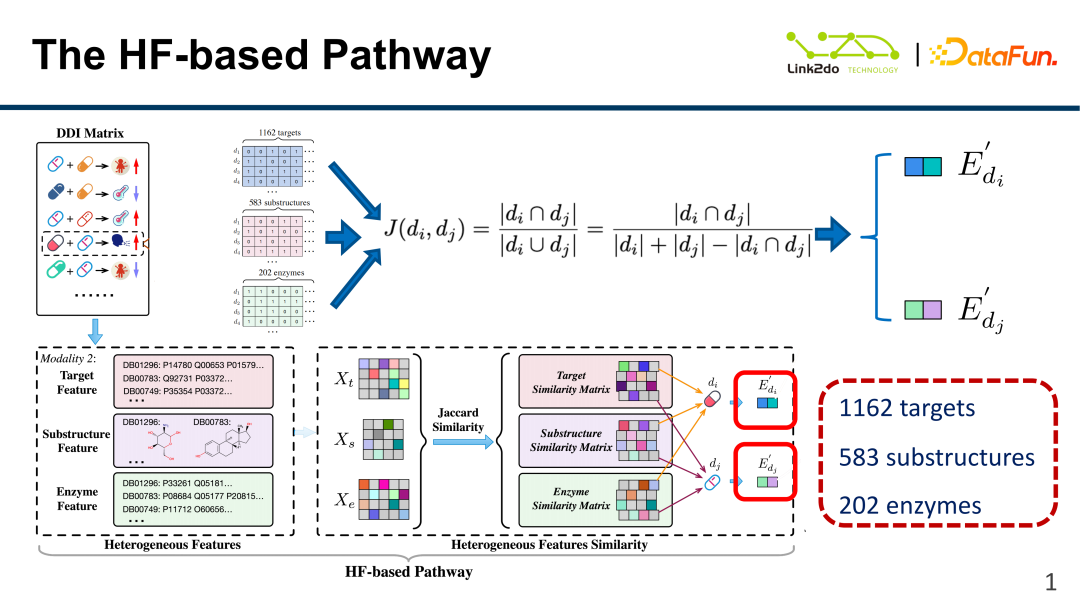
#Final fusion The three similarity matrices obtain the E' corresponding to each drug, that is, the information based on the isomeric characteristics of the drug is obtained. The dimension of this feature vector is also small, including information on 1162 targets, 583 structures and 202 enzymes.
4. Multi-model fusion layer
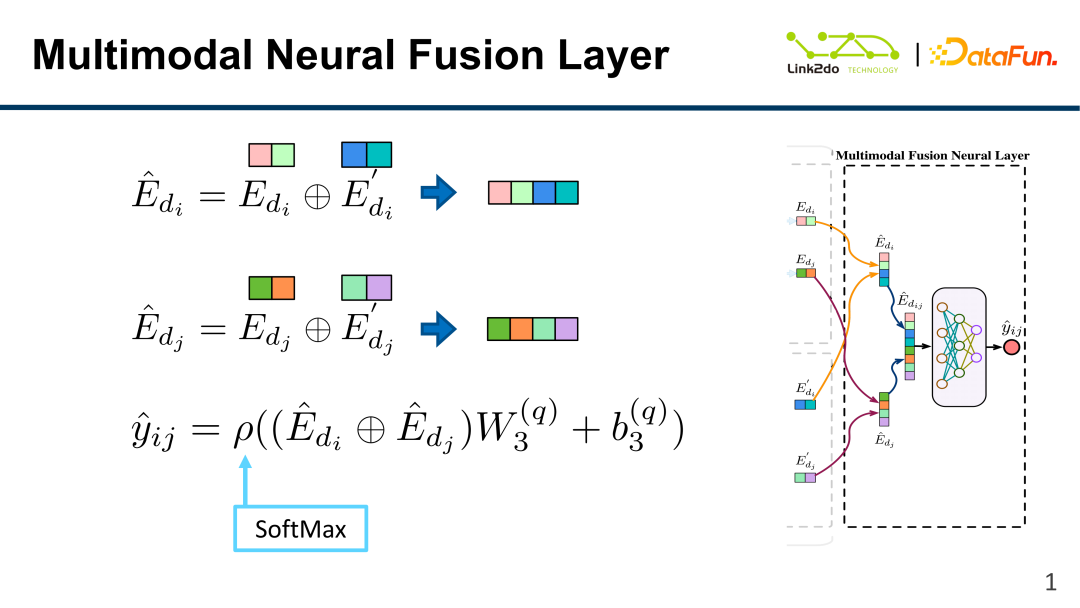
As shown in the figure above, the DKG result E and HF result E' of each drug are finally spliced and fused through the fusion layer to obtain:

Then use the softmax function to get the output layer:

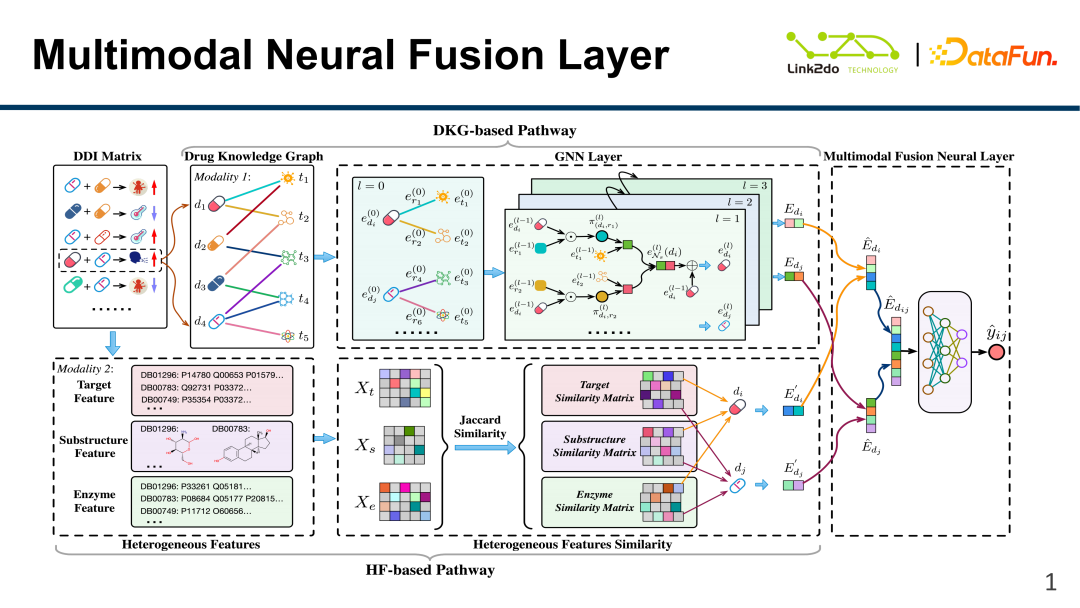 ##
##
The entire model framework is as shown above. The framework structure is not complicated, but it combines drug information relatively effectively.
3. MDNN model effect
Next, I will share with you the model effect.

The above figure shows the comparison results with the more commonly used algorithm currently, the MDNN algorithm It has achieved State of the Art results in Acc, AUC, F1, AUPR, Precision, Recall and other evaluation indicators. (The above algorithm is not incorporated into the GNN algorithm.)
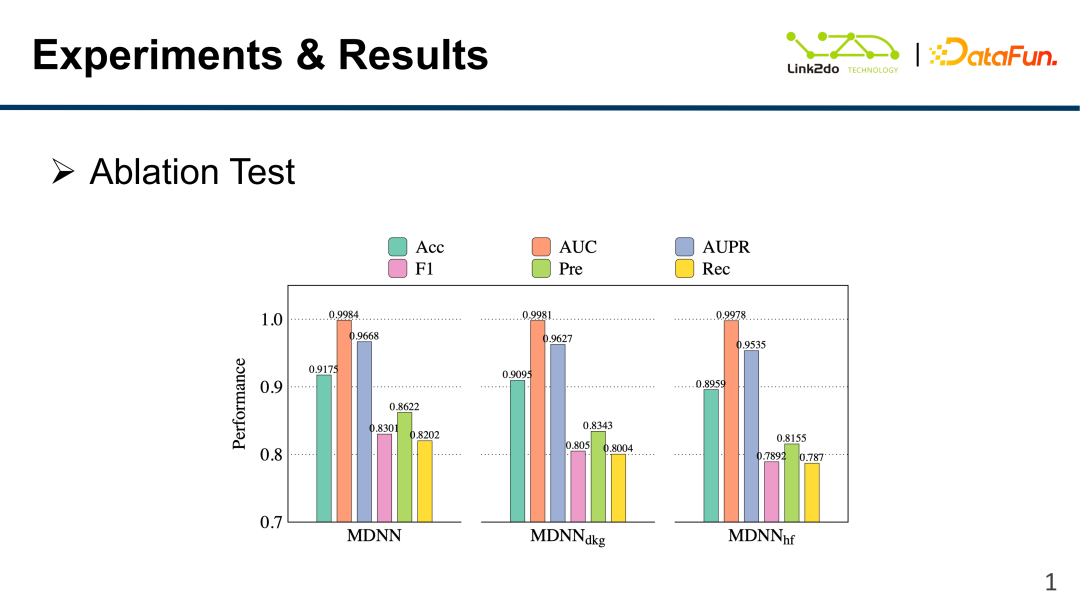
##The above figure shows the MDNN fusion of DKG, Differences between effects of HK and no fusion. It is easy to see that the result of the fusion is better than using either method alone.
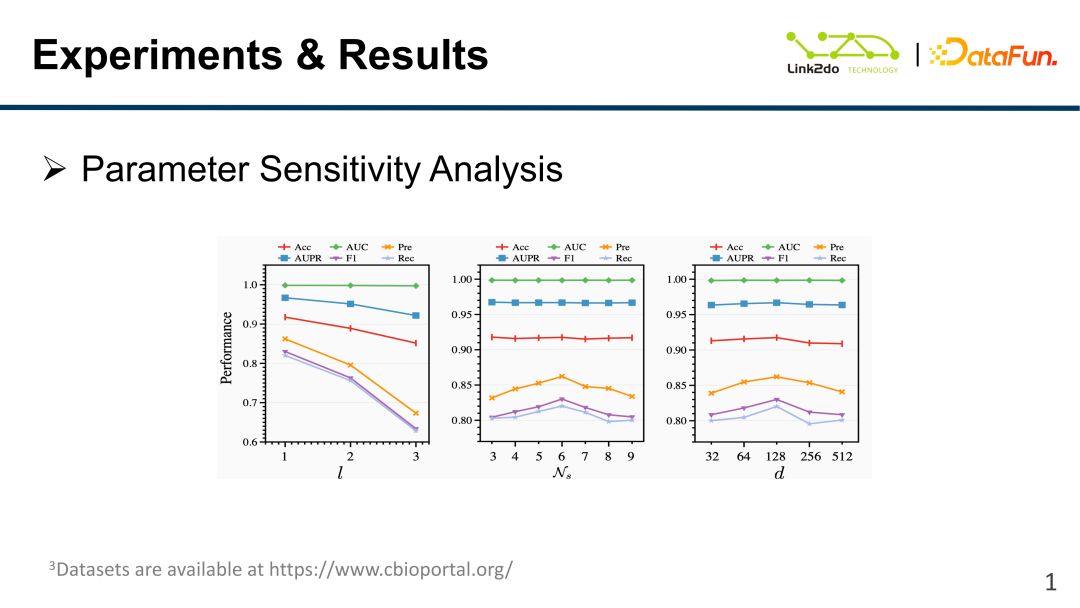
Regarding multi-modal parameter adjustment, that is, the analysis of parameter sensitivity is as shown in the figure above, respectively. It shows the various evaluation indicators when the number of neural network layers l, the number of nodes Ns and other parameters change. corresponding fluctuations.
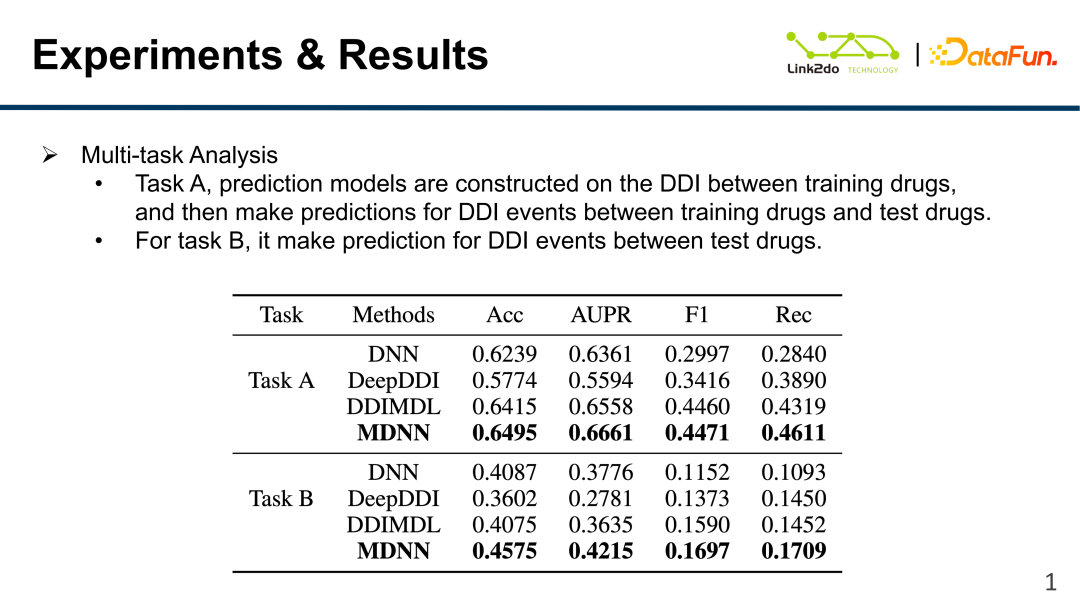
In addition, multi-task analysis was also conducted. The task A prediction model was constructed through the training set. To predict the DDI between drugs in the training set and the drugs in the test set; the prediction model of task B is also built through the training set, but predicts the DDI between drugs in the test set. If the training set and test set drugs are strictly separated, the model prediction effect will be significantly reduced.
#There are still many problems that need to be solved in the field of drug research and development: how to effectively discover/screen drugs instead of just studying DDI.
4. Summary
Finally, to summarize the content shared this time, the MDNN algorithm itself is not complicated. The important work is the use of multi-modal data and structural information:
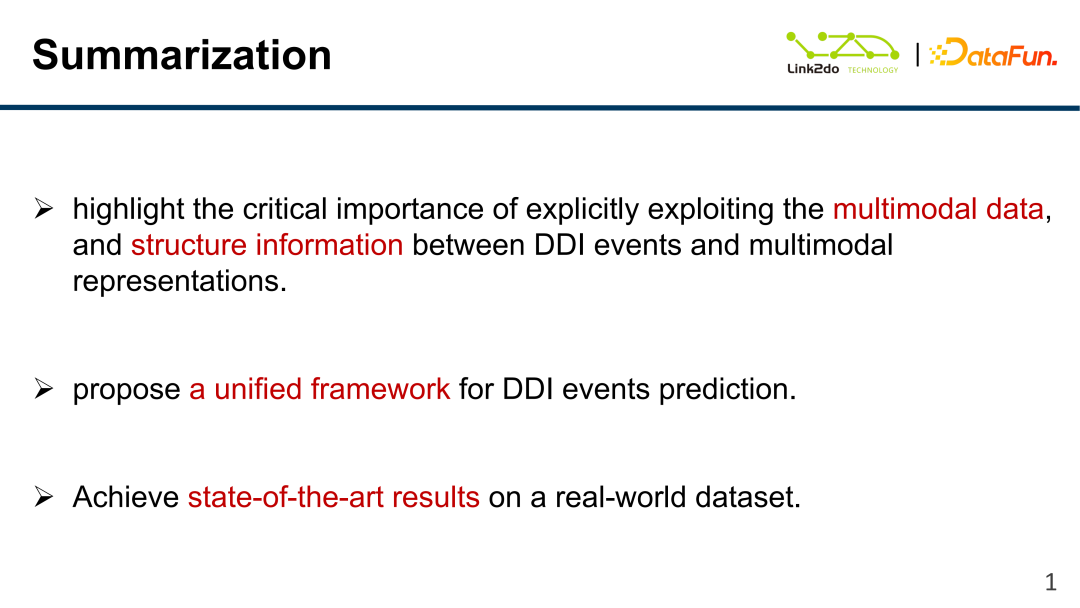
(2) Improved the prediction problem of DDI;
(3) Comparison with existing methods ,MDNN works best on the data set.
#But in practical applications, the MDNN model still has many areas that need further optimization and improvement, such as better methodology or better data.
5. Q&A session
#Q1: Is the "Drug Bank" data set a public data set?
A1: The knowledge graph data set of this study is public, and the original data set "Drug Bank" is also a public data set. However, depending on the drugs in each research field, the knowledge graph data sets constructed will also be different, and there is no unified and universal knowledge graph.
Q2: What are the applications of the shared research methods such as knowledge graphs, multi-modal fusion, etc. outside of the pharmaceutical field? Such as protein, immunity, etc.?
A2: In addition to biopharmaceuticals, there are many applications in the e-commerce field. For example, in the User-Item class data set, User has a lot of multi-modal information, such as occupation, age, shopping tags, etc. Item products also have a lot of information, and there are many relationships between them, such as shopping, evaluation, favorites, clicks, etc. Behavior. If the domain data conforms to the heterogeneous form, you can try to use these methods for analysis. The difficulty lies in building a knowledge graph in a specific domain.
The above is the detailed content of Application of multimodal DNN models in drug interaction prediction tasks. For more information, please follow other related articles on the PHP Chinese website!

Hot AI Tools

Undresser.AI Undress
AI-powered app for creating realistic nude photos

AI Clothes Remover
Online AI tool for removing clothes from photos.

Undress AI Tool
Undress images for free

Clothoff.io
AI clothes remover

AI Hentai Generator
Generate AI Hentai for free.

Hot Article

Hot Tools

Notepad++7.3.1
Easy-to-use and free code editor

SublimeText3 Chinese version
Chinese version, very easy to use

Zend Studio 13.0.1
Powerful PHP integrated development environment

Dreamweaver CS6
Visual web development tools

SublimeText3 Mac version
God-level code editing software (SublimeText3)

Hot Topics
 1377
1377
 52
52
 How to add a new column in SQL
Apr 09, 2025 pm 02:09 PM
How to add a new column in SQL
Apr 09, 2025 pm 02:09 PM
Add new columns to an existing table in SQL by using the ALTER TABLE statement. The specific steps include: determining the table name and column information, writing ALTER TABLE statements, and executing statements. For example, add an email column to the Customers table (VARCHAR(50)): ALTER TABLE Customers ADD email VARCHAR(50);
 What is the syntax for adding columns in SQL
Apr 09, 2025 pm 02:51 PM
What is the syntax for adding columns in SQL
Apr 09, 2025 pm 02:51 PM
The syntax for adding columns in SQL is ALTER TABLE table_name ADD column_name data_type [NOT NULL] [DEFAULT default_value]; where table_name is the table name, column_name is the new column name, data_type is the data type, NOT NULL specifies whether null values are allowed, and DEFAULT default_value specifies the default value.
 SQL Clear Table: Performance Optimization Tips
Apr 09, 2025 pm 02:54 PM
SQL Clear Table: Performance Optimization Tips
Apr 09, 2025 pm 02:54 PM
Tips to improve SQL table clearing performance: Use TRUNCATE TABLE instead of DELETE, free up space and reset the identity column. Disable foreign key constraints to prevent cascading deletion. Use transaction encapsulation operations to ensure data consistency. Batch delete big data and limit the number of rows through LIMIT. Rebuild the index after clearing to improve query efficiency.
 How to set default values when adding columns in SQL
Apr 09, 2025 pm 02:45 PM
How to set default values when adding columns in SQL
Apr 09, 2025 pm 02:45 PM
Set the default value for newly added columns, use the ALTER TABLE statement: Specify adding columns and set the default value: ALTER TABLE table_name ADD column_name data_type DEFAULT default_value; use the CONSTRAINT clause to specify the default value: ALTER TABLE table_name ADD COLUMN column_name data_type CONSTRAINT default_constraint DEFAULT default_value;
 Use DELETE statement to clear SQL tables
Apr 09, 2025 pm 03:00 PM
Use DELETE statement to clear SQL tables
Apr 09, 2025 pm 03:00 PM
Yes, the DELETE statement can be used to clear a SQL table, the steps are as follows: Use the DELETE statement: DELETE FROM table_name; Replace table_name with the name of the table to be cleared.
 How to deal with Redis memory fragmentation?
Apr 10, 2025 pm 02:24 PM
How to deal with Redis memory fragmentation?
Apr 10, 2025 pm 02:24 PM
Redis memory fragmentation refers to the existence of small free areas in the allocated memory that cannot be reassigned. Coping strategies include: Restart Redis: completely clear the memory, but interrupt service. Optimize data structures: Use a structure that is more suitable for Redis to reduce the number of memory allocations and releases. Adjust configuration parameters: Use the policy to eliminate the least recently used key-value pairs. Use persistence mechanism: Back up data regularly and restart Redis to clean up fragments. Monitor memory usage: Discover problems in a timely manner and take measures.
 phpmyadmin creates data table
Apr 10, 2025 pm 11:00 PM
phpmyadmin creates data table
Apr 10, 2025 pm 11:00 PM
To create a data table using phpMyAdmin, the following steps are essential: Connect to the database and click the New tab. Name the table and select the storage engine (InnoDB recommended). Add column details by clicking the Add Column button, including column name, data type, whether to allow null values, and other properties. Select one or more columns as primary keys. Click the Save button to create tables and columns.
 How to create an oracle database How to create an oracle database
Apr 11, 2025 pm 02:33 PM
How to create an oracle database How to create an oracle database
Apr 11, 2025 pm 02:33 PM
Creating an Oracle database is not easy, you need to understand the underlying mechanism. 1. You need to understand the concepts of database and Oracle DBMS; 2. Master the core concepts such as SID, CDB (container database), PDB (pluggable database); 3. Use SQL*Plus to create CDB, and then create PDB, you need to specify parameters such as size, number of data files, and paths; 4. Advanced applications need to adjust the character set, memory and other parameters, and perform performance tuning; 5. Pay attention to disk space, permissions and parameter settings, and continuously monitor and optimize database performance. Only by mastering it skillfully requires continuous practice can you truly understand the creation and management of Oracle databases.



